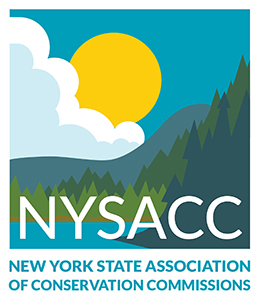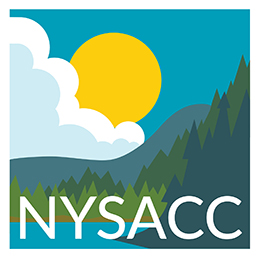Focus on a CAC
|
NYSACC would like to offer its members the opportunity to share with us the things they’ve done and provide us with information we can use. To start the ball rolling, the Town of Bedford Conservation Board presents a few of the things it cares about. Short Description of Bedford The town, composed of three hamlets, Bedford Hills, Bedford Village, and Katonah, is 39.42 square miles, with a population of 17,755 (2018). Although its location is about 40 miles north of New York City, it’s not your typical bedroom community. About 60% of its land is open space (having two NYC reservoirs, one nearly completely in Bedford, does help), and its history is quite unique. Founded in 1680, as a town in Connecticut, it was transferred to New York in a boundary dispute, settled by King William III of England. The town served as the county seat of Westchester County during the American Revolutionary War, until Bedford Village was burned by the British in July 1779. Bedford Village was rebuilt, and is now a national historic district. John Jay, the first Chief Justice of the Supreme Court, retired to Bedford, and his home, the Jay Homestead, is a historic state park. |

The “Chapman” house being moved from Old Katonah to New Katonah circa 1900. Note the two horses circling a capstan post which in turn pull tow ropes attached to framing under the house. Owners, with their clothes drying on their front porch, lived in the house during the approximately 6 weeks move.
| Katonah, the hamlet at the north end of town, was founded in the 1840’s when the railroad came north, and flourished as a stop on the daily milk train going south. However, in 1894, New York City ordered Katonah torn down due to their plans to enlarge the Croton Reservoir, at that time the city’s sole source of drinking water, which would inundate parts of Katonah that were too close. Instead, with the help of New York City, Katonah starting in 1897, and lasting 10 years, moved 55 of its large Victorian homes and barns, ¾ miles south to its present location, crossing a river and up and down hills, using only horsepower and laundry detergent lubricated, straight Georgian pine tracks. supported by wooden cribbing. The relocated homes form a national historic district. |

The majestic “Bedford Oak”, symbol of the town, is estimated to be over 500 years, its girth is more than 23 feet, and the spread of its branches is 120 feet from tip to tip.
|
Conservation Board Formed in 1969 as a CAC (possibly the 2nd oldest CAC in the state). Bedford became a Conservation Board in 1975. It presently has 9 full members and 3 associate members. Of its 9 full members, 3 members are required to be from each of its hamlets. Site Visit Checklist – evaluating an application that comes before one of our town’s regulatory boards/commissions for its environmental impact on our community is one of our core functions. It all starts with the site visit. Here’s our one-page checklist. Feel free to copy or amend. We borrowed it from the Town of Yorktown Conservation Board. Remember: ALWAYS get the permission of the landowner, before you go onto their property. Yes, you may have the right, as applicant is before the town, but going on a property unannounced and not approved should never be done.
Ordinances that were initiated by the board or supported through its passage (this link connects to the Bedford Code, where the referenced chapters can be found):
|
|
Projects completed by the Conservation Board
|

Photo by Susan Roos taken in 2018 with members of the Conservation Board doing maintenance and planting work on the Rain Garden located in front of Bedford Town Hall. The fellow in the center with the suit and tie is our Honorable Supervisor, Chris Burdick
|
- Conservation Board “Green Awards” – started in 2011, from an idea of one of our members borrowed from Yonkers, NY, the Conservation has presented (more or less annually) its “Green Award” to an individual, school, NGO, or business, who has made their natural environment within Bedford a better place, and who has not received recognition before. The presentation occurs at a Town Board meeting, with the recipients describing their project, with the event ending with a photo in our local newspaper of that year’s recipients along with the Conservation Board and Town Board members. Win. Win. Win.
Public Outreach
One of the most important responsibilities that a Conservation Board can have is to get the message of good environmental planning and stewardship to the public. Conservation Boards, being a creature of their municipality, don’t have money to hire a public relations team, and certainly didn’t start off with an email list of interested individuals. So, it takes some time and brain-storming to find a way to reach residents. One lesson we’ve learned is to partner with other departments in our town, or other environmental groups. Here’s some of the ways we’ve tried to reach people with our message:
- Social Media – we started a Bedford Conservation Board Face Book page two years ago, and it has slowly gained a following. It’s run by one of our members, who gave it a lot of thought prior to going live. We re-post from good sources, especially the Department of Environmental Conservation, as well as producing our own articles. Here’s our link: https://www.facebook.com/Town-of-Bedford-Conservation-Board-432285443827067/.
- Bedford Recreation and Parks Department Newsletter – which is published quarterly. For no cost, we get a page. Here are some examples of articles that we’ve written (the graphics come from a terrific local graphic artist). To read each article, click on it.



|
 |






You must be logged in to post a comment.